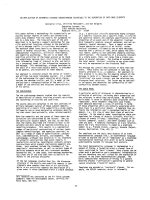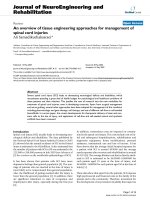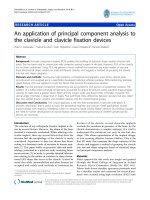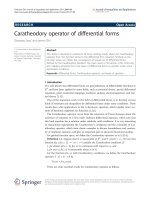Báo cáo hóa học: " AN APPROXIMATION OF SOLUTIONS OF VARIATIONAL INEQUALITIES" potx
Bạn đang xem bản rút gọn của tài liệu. Xem và tải ngay bản đầy đủ của tài liệu tại đây (536.49 KB, 12 trang )
AN APPROXIMATION OF SOLUTIONS
OF VARIATIONAL INEQUALITIES
JINLU LI AND B. E. RHOADES
Received 27 October 2004 and in revised form 15 December 2004
We use a Mann-type iteration scheme and the metric projection operator (the nearest-
point projection operator) to approximate the solutions of variational inequalities in uni-
formly convex and uniformly smooth Banach spaces.
1. Introduction
Let (B,·) be a Banach space with the topological dual space B
∗
,andletϕ,x denote
the duality pairing of B
∗
and B,whereϕ ∈ B
∗
and x ∈ B.Let f : B → B
∗
be a mapping
and let K be a nonempty, closed, and convex subset of B. The (general) variational in-
equality defined by the mapping f and the set K is
VI( f ,K):findx
∗
∈ K such that
f (x
∗
),x − x
∗
≥ 0foreveryx ∈ K.
(1.1)
The nonlinear complementarily problem defined by f and K is by definition as fol lows:
NCP( f ,K):findx
∗
∈ K such that
f (x
∗
),x
≥ 0,
for every x ∈ K and
f (x
∗
),x
∗
=
0.
(1.2)
It is known (see [5, 6]) that when K is a closed convex cone, problems NCP( f ,K)and
VI( f ,K) are equivalent.
To study the existence of solutions of the NCP( f ,K)andVI(f ,K)problems,many
authors have used the techniques of KKM mappings, and the Fan-KKM theorem from
fixed point theory (see [1, 5, 6, 7, 8, 9, 10]). In case B is a Hilbert space, Isac and other
authors have used the notion of “exceptional family of elements” (EFE) and the Leray-
Schauder alternative theorem (see [5, 6]).
In [1, 2], Alber generalized the metr ic projection operator P
K
to a generalized pro-
jection operator π
K
: B
∗
→ K from Hilbert spaces to uniformly convex and uniformly
smooth Banach spaces and Alber used this operator to study VI( f ,K)problemsandto
Copyright © 2005 Hindawi Publishing Corporation
Fixed Point Theory and Applications 2005:3 (2005) 377–388
DOI: 10.1155/FPTA.2005.377
378 Solutions of variational inequalities
approximate the solutions by an iteration sequence. In [7], the author used the general-
ized projection operator and a Mann-type iteration sequence to approximate the solu-
tions of the VI( f ,K)problems.
In case B is a uniformly convex and uniformly smooth Banach space, the continuity
property of the metric projection operator P
K
has been studied by Goebel, Reich, Roach,
and Xu (see [4, 12, 13]). In this paper, we use the operator P
K
and a Mann-type iteration
scheme to approximate the solutions of NCP( f ,K)problems.
2. Preliminaries
Let (X,·) be a normed linear space and let K be a nonempt y subset of X.Forevery
x ∈ X, the distance between a point x and the set K is denoted by d(x,K)andisdefined
by the following minimum equation
d(x,K) = inf
y∈K
x − y. (2.1)
The metric projection operator (or the nearest-point projection operator) P
K
defined
on X is a mapping from X to 2
K
:
P
K
(x) =
z ∈ X : x − z=d(x, K), ∀x ∈ X
. (2.2)
If P
K
(x) =∅,foreveryx ∈ X,thenK is cal led proximal.IfP
K
(x) is a singleton for
ever y x ∈ X,thenK is said to be a Chebyshev set.
Theorem 2.1. Let (B,·) beareflexiveBanachspace.ThenB is strictly convex if and only
if every nonempty closed convex subset K ⊂ B is a Chebyshev set.
Since uniformly convex and uniformly smooth Banach spaces are reflexive and strictly
convex, the above theorem implies that if (B,·) is a uniformly convex and uniformly
smooth Banach space, then every nonempty closed convex subset K ⊂ B is a Chebyshev
set.
Let T be a uniformly convex Banach space. Its modulus of convexity is denoted by δ
and is defined by
δ(
) = inf
1 −
1
2
x + y : x=y=1, x − y=
. (2.3)
It follows that δ is a strictly increasing, convex, and continuous function from (0, 2] to
[0,1], and it is known that δ()/ is nondecreasing on (0,2].
If B is uniformly smooth, its modulus of smoothness is denoted by ρ(τ)andisdefined
by
ρ(τ)
=
1
2
x + y +
1
2
x − y−1:x=1 ·y≤τ
. (2.4)
It can be shown that ρ is a convex and continuous function from [0,∞)to[0,∞)with
the properties that ρ(τ)/τ is nondecreasing, ρ(τ) ≤ τ for all τ ≥ 0, and lim
τ→0
+
ρ(τ)/τ = 0.
For the details of the proper ties of δ and ρ, the reader is refereed to [10, 11].
J. Li and B. E. Rhoades 379
Theorem 2.2 (Xu and Roach [13]). Let M beaconvexChebyshevsetofauniformlyconvex
and uniformly smooth Banach spaces X and let P;X → M be the me tric projection. Then
(i) P is Lipschitz continuous mod M; namely, there exists a constant k>0 such that
P(x) − z
≤ kx − z, for any x ∈ X and z ∈ M, (2.5)
(ii) P is uniformly continuous on every bounded subset of X and, furthermore, the re exist
positive constants k
r
for every B
r
:={x ∈ X : x≤r} such that
P(x) − P(y)
≤x − y + kδ
−1
ψ
x − y
, for any x, y ∈ B
r
, (2.6)
where ψ is defined by
ψ(t) =
t
0
ρ(s)
s
ds. (2.7)
Theorem 2.3 (Xu and Roach [13]). If X = L
p
,
p
,orW
p
m
(1 <p<∞) in Theorem 2.2, then
the metr ic projection P is H
¨
older continuous on every bounded subset of X,and,moreover,
there exist positive k
r
for every B
r
such that
P(x) − P(y)
≤ k
r
x − y
min(2,p)/ max(2,p)
, for any x, y ∈ B
r
. (2.8)
The normalized duality mapping J : B → 2
B
∗
is defined by
J(x) =
j(x) ∈ B
∗
:
j(x),x
=
j(x)
x=x
2
=
j(x)
2
. (2.9)
Clearly, j(x) is the B
∗
-norm of j(x)andx is its B-norm. It is known that if B is
uniformly convex and uniformly smooth, then J is a single-valued, strictly monotone,
homogeneous, and uniformly continuous operator on each bounded set. Furthermore, J
is the identity in Hilbert spaces; that is, J
= I
H
.
The following theorem provides a tool to solve a variational inequality by finding a
fixed point of a certain operator.
Theorem 2.4 (Li [8]). Let (B,
·) be a reflexive and smooth Banach space and K ⊂ B a
nonempty closed convex subset. For any given x ∈ B, x
0
∈ P
K
(x) if and only if
J
x − x
0
,x
0
− y
≥ 0, ∀y ∈ K. (2.10)
Let F : K → B be a mapping. The locality variational inequality defined by the mapping
F and the set K is
LVI(F,K):findx
∗
∈ K and j
F
x
∗
∈ J
F
x
∗
such that
j
F
x
∗
, y − x
∗
≥ 0, for every y ∈ K.
(2.11)
380 Solutions of variational inequalities
The next theorem follows from Theorem 2.4.
Theorem 2.5 (Li [8]). Let (B,·) be a reflexive and smooth Banach space and K ⊂ B a
nonempty closed convex subse t. Let F : B → B be a mapping. Then an element x
∗
∈ KE is a
solution of LVI(F,K) if and only if x
∗
∈ P
K
(x
∗
− F(x
∗
)).
3. The compact case
Theorem 3.1. Let (B,·) be a uniformly convex and uniformly smooth Banach space and
K a nonempty compact convex subset of B.LetF : K → B be a continuous mapping. Suppose
that LVI(F,K) has a solution x
∗
∈ K and F satisfies the following condition:
x − x
∗
−
F(X) − F
x
∗
+ k
r
δ
−1
ρ
x − x
∗
−
F(X) − F
x
∗
≤
x − x
∗
, for every x ∈ K,
(3.1)
where k
r
is the positive constant given in Theorem 2.2 that depends on the bounded subset
K.Foranyx
0
∈ K, define the Mann iteration scheme as follows:
x
n+1
=
1 − α
n
x
n
− α
n
P
K
x
n
− F
x
n
, n = 1,2,3, , (3.2)
where {α
n
} satisfies conditions (a) 0 ≤ α
n
≤ 1 for all n,(b)
α
n
(1 − α
n
) =∞. Then there
exists a subseque nce {n(i)}⊆{n} such that {x
n(i)
} convergestoasolutionx
of LVI(F,K).
Proof. Since B is uniformly convex and uniformly smooth, there exists a continuous
strictly increasing and convex function g : R
+
→ R
+
such that g(0) = 0and,forallx, y ∈
B
r
(0) :={x ∈ E : x≤r} and for any α ∈ [0,1], we have
αx +(1− α)y
2
≤ αx
2
+(1− α)y
2
− α(1 − α)g
x − y
, (3.3)
where r is a positive number such that K ⊆ B
r
(0) (see [3]). Since x
∗
isasolutionof
LVI(F,K), from Theorems 2.1 and 2.5, x
∗
= P
K
(x
∗
− F(x
∗
)). Using Theorem 2.2,
x
n+1
− x
∗
2
=
1 − α
n
x
n
− x
∗
+ α
n
P
K
x
n
− F
x
n
− x
∗
2
≤
1 − α
n
x
n
− x
∗
2
+ α
n
P
K
x
n
− F
x
n
− x
∗
2
− α
n
1 − α
n
g
x
n
− x
∗
−
P
K
x
n
− F
x
n
− x
∗
=
1 − α
n
x
n
− x
∗
2
+ α
n
P
K
x
n
− F
x
n
− x
∗
2
− α
n
1 − α
n
g
P
K
x
n
− F
x
n
− x
n
≤
1 − α
n
x
n
− x
∗
2
+ α
n
x
n
− F
x
n
−
x
∗
− F(x
∗
)
+ k
r
δ
−1
ψ
x
n
− F
x
n
−
x
∗
− F
x
∗
2
− α
n
1 − α
n
g
P
K
x
n
− F
x
n
− x
n
.
(3.4)
J. Li and B. E. Rhoades 381
Since ρ(τ)/τ is nondecreasing and lim
τ→0
+
ρ(τ)/τ = 0,
ψ
x
n
− F
x
n
−
x
∗
− F
x
∗
=
(x
n
−F(x
n
))−(x
∗
−F(x
∗
))
0
ρ(s)
s
ds
≤
ρ
x
n
− F
x
n
−
x
∗
− F
x
∗
x
n
− F
x
n
−
x
∗
− F
x
∗
x
n
− F
x
n
−
x
∗
− F
x
∗
= ρ
x
n
− F
x
n
−
x
∗
− F
x
∗
.
(3.5)
Applying condition (3.1) and the above inequality, we obtain
x
n+1
− x
∗
2
≤
1 − α
n
x
n
− x
∗
2
+ α
n
x
n
− F
x
n
−
x
n
− F
x
∗
+ k
r
δ
−1
ρ
x
n
− F
x
n
−
x
∗
− F
x
∗
2
− α
n
1 − α
n
g
P
K
x
n
− F
x
n
− x
n
≤
1 − α
n
x
n
− x
∗
2
+ α
n
x
n
− x
∗
2
− α
n
1 − α
n
g
P
K
x
n
− F
x
n
− x
n
=
x
n
− x
∗
2
− α
n
1 − α
n
g
P
K
x
n
− F
x
n
− x
n
.
(3.6)
Therefore
α
n
1 − α
n
g
P
K
x
n
− F
x
n
− x
n
≤
x
n
− x
∗
2
−
x
n+1
− x
∗
2
, n = 1,2,
(3.7)
For any positive integer m, taking the sum for n
= 1,2,3, ,m,wehave
m
n=1
α
n
1 − α
n
g
P
K
x
n
− F
x
n
− x
n
≤
x
1
− x
∗
2
−
x
n+1
− x
∗
2
≤
x
1
− x
∗
2
,
(3.8)
which implies that
∞
n=1
α
n
1 − α
n
g
P
K
x
n
− F
x
n
− x
n
≤
x
1
− x
∗
2
. (3.9)
From the condition
α
n
(1 − α
n
) =∞, there exists a subsequence {n(i)}⊆{n} such
that g(P
K
(x
n(i)
− F(x
n(i)
)) − x
n(i)
) → 0asi →∞.Sinceg is continuous and strictly
382 Solutions of variational inequalities
increasing such that g(0) = 0, we obtain
P
K
x
n(i)
− F
x
n(i)
− x
n(i)
−→ 0asi −→ ∞ . (3.10)
From the compactness of K, there exists a subsequence of {x
n(i)
} which, without loss
of generality, we may assume is the sequence {n(i)}, and an element x
∈ K such that
x
n(i)
→ x
and i →∞. From the continuity of P
K
and F,wehaveP
K
(x
n(i)
− F(x
n(i)
)) →
P
K
(x
− F(x
)) as i →∞. Statement (3.10) implies that P
K
(x
− F(x
)) = x
.Applying
Theorem 2.5, x
is a solution of the LVI(F, K)problem.
Corollary 3.2. Theorem 3.1 is still true if condition (3.1) is replaced by the following con-
dition:
x − x
∗
−
F(x) − F
x
∗
+ kδ
−1
x − x
∗
−
F(x) − F
x
∗
≤
x − x
∗
, for every x ∈ K.
(3.11)
Proof. From the property ρ(τ) ≤ τ for all τ ≥ 0, and the nondecreasing property of δ
(and δ
−1
), condition (3.11) implies condition (3.1). The conclusion of the corollary then
follows immediately from Theorem 3.1.
One of the most important types of variational inequalities and complementarily
problems deals with completely continuous field mappings. This type of variational in-
equality and complementarily problem has been studied by many authors in Hilbert
spaces (see, e.g., [5, 6]). Recently, the first author and Isac have studied the existence of
solutions of this type problem in uniformly convex and uniformly smooth Banach spaces.
Recall that a mapping T : B
→ B is completely continuous if T is continuous, and for
any bounded set D ⊂ B,wehavethatT(D) is relatively compact. A mapping F : B → B
has a completely continuous field if F has a representation F(x) = x − T(X)forallx ∈ B,
where T : B → B is a completely continuous mapping.
As an application of Theorem 3.1 we have the following corollary.
Corollary 3.3. Let (B,
·) be a uniformly convex and uniformly smooth Banach space,
K ⊂ B a closed convex cone, and F : B → B a completely continuous field with the represen-
tation F(x) = x − T(x).SupposethatLVI(F,K) has a solution x
∗
∈ K and that T satisfies
the condition
T(x) − T
x
∗
+ kδ
−1
ρ
T(x) − T
x
∗
≤
x − x
∗
for every x ∈ K, (3.12)
where k
r
is the positive constant given in Theorem 2.2 that depends on the bounded subset
K.Thenthereexistsasubsequence{n(i)} of the sequence defined by (3.2) such that {x
n(i)
}
converges to a solut ion of LVI(F, K).
Proof. Replacing F(x)byx − T(x)in(3.1)ofTheorem 3.1 yields the conclusion of the
corollary .
J. Li and B. E. Rhoades 383
It is well known that L
p
,
p
,andW
p
m
(1 <p<∞) are special unifor mly convex and
uniformly smooth Banach spaces. In [2], Alber and Notik provided formulas for the
calculation of the modulus of convexity δ and the modulus of smoothness ρ for these
spaces:
δ() =
1
8
(p − 1)
2
+ o
2
≥
1
8
(p − 1)
2
,1<p≤ 2,
1 −
1 −
2
p
1/p
≥
1
p
2
p
,2≤ p<∞,
ρ(τ) =
1+τ
p
1/p
− 1 ≤
1
p
τ
p
,1<p≤ 2,
p − 1
2
τ
2
+ o
τ
2
≤
p − 1
2
τ
2
,2≤ p<∞.
(3.13)
Applying the above formulas to Theorem 3.1, we can obtain more detailed applica-
tions and examples.
Corollary 3.4. Let B = L
p
,
p
or W
p
m
(1 <p<∞) and K a nonempty compact convex
subset of B.LetF : B → B be a completely continuous field with the representation F(x) =
x − T(x).SupposethatLVI(F, K) has a solution x
∗
∈ K and, for every x ∈ K,T satisfies the
following conditions:
T(x) − T
x
∗
≤
min
1
2
x − x
∗
,
1
4k
r
2/p
p(p − 1)
2
1/p
x − x
∗
2/p
if 1 <p≤ 2,
T(x) − T
x
∗
≤
min
1
2
x − x
∗
,
1
2k
r
p
4
p(p − 1)
2
x − x
∗
p/2
if 2 ≤ p<∞,
(3.14)
where k
r
is the positive constant given in Theorem 2.2.Thenthereexistsasubsequence{n(i)}
ofthesequencedefinedby(3.2) such that {x
n(i)
} converges to a solution x
of LVI(F,K).
Proof. Assume that 1 <p≤ 2. From the inequality
δ() ≥
1
8
(p − 1)
2
, (3.15)
we obtain
δ
−1
() ≤
8
p − 1
1/2
. (3.16)
384 Solutions of variational inequalities
Noting that both δ and ρ are strictly increasing, and using the inequality ρ(τ) ≤ τ
p
/p,
we have
T(x) − T
x
∗
+ k
r
δ
−1
ρ
T(x) − T
x
∗
≤
1
2
x − x
∗
+ k
r
δ
−1
1
p
T(x) − T
x
∗
p
≤
1
2
x − x
∗
+ k
r
8
p(p − 1)
T(x) − T
x
∗
p
1/2
≤
x − x
∗
.
(3.17)
The last inequality follows from the condition of this corollary. Then this case can be
obtained by using Corollary 3.4. The case for 2 ≤ p<∞ can be proved similarly.
Theorem 3.5. Let B, K, F be as in Theorem 3.1.Ifinequality(3.1) holds for all solutions of
LVI(F,K),thenthesequence{x
n
} defined by (3.2)convergestoasolutionx
of the LVI(F,K)
problem.
Proof. From Theorem 3.1, {x
n
} has a subsequence {x
n(i)
} that converges to a solution x
,
as i →∞.IntheproofofTheorem 3.1,replacingx
∗
by x
,weobtain
x
n
− x
2
≤
x
n
− x
2
− α
n
1 − α
n
g
P
K
x
n
− F
x
n
− x
n
≤
x
n
− x
2
, n = 1,2,3, ,
(3.18)
which implies that {x
n
− x
2
} is a decreasing sequence. Since there exists a subsequence
{x
n(i)
} such that x
n(i)
− x
→0asi →∞, we obtain the fact that x
n
− x
→0asn →∞.
Corollary 3.6. Let B, K, F be as in Theorem 3.1.Ifinequality(3.1)holdsforally ∈ K,
then the sequence defined by (3.2)convergestoasolutionx
of the LVI(F,K) problem.
Proof. This corollary follows immediately from Theorem 3.5.
If we apply Theorem 2.3 to the special uniformly convex and uniformly smooth Ba-
nach spaces L
p
,
p
,andW
p
m
(1 <p<∞), and apply the techniques of the proof of Theorem
3.1, we obtain the following.
Theorem 3.7. Let B = L
p
,
p
, or W
p
m
(1 <p<∞) and K a nonempty compact convex subset
of B.LetF : K → B be a continuous mapping. Suppose that LVI( F,K) as a solution x
∗
∈ K
and F satisfies the following:
k
r
x − x
∗
−
F(x) − F
x
∗
min(2,p)/ max(2,p)
≤
x − x
∗
for any x ∈ K, (3.19)
J. Li and B. E. Rhoades 385
where k
r
is the positive constant given in Theorem 2.2 that depends on the bounded subset K.
Then there exists a subsequence {x
n(i)
} of the sequence {x
n
} defined by (3.2)thatconverges
to a solution x
of LVI(F,K).
Proof. Here we use Theorem 2.3 to obtain
P
K
x
n
− F
x
n
− P
K
x
∗
− F
x
∗
≤ k
r
x − F(x)
−
x
∗
− F
x
∗
min(2,p)/ max(2,p)
.
(3.20)
The rest of the proof is similar to that of Theorem 3.1.
Corollary 3.8. Let B, K, F be as in Theorem 3.5.Ifinequality(3.19)holdsforallsolu-
tions of LVI(F,K), then the sequence {x
n
} defined by (3.2)convergestoasolutionx
of the
LVI(F,K) problem.
Corollary 3.9. Let B, K, F be as in Theorem 3.1.Ifinequality(3.19)holdsforally ∈ K,
then the sequence {x
n
} defined by (3.2)convergestoasolutionoftheLVI(F,K) problem.
4. The unbounded case
If K is unbounded, for example, if K is a closed convex cone, the following theorems are
needed for estimation.
Theorem 4.1 (Xu and Roach [13]). Let M beaconvexChebyshevsetofauniformlyconvex
and uniformly smooth Banach space X and P : X → M be the metric projection. Then, for
every x, y ∈ X,
P(x) − P(y)
≤x − y +4
x − P(x)
∨
P(x) − y
)δ
−1
C
1
ψ
x − y
x − P(y)
∨
y − P(x)
,
(4.1)
where C
1
is a fixed constant and ψ is as defined in Theorem 2.2.
Theorem 4.2. Let (B,·) be a uniformly convex and uniformly smooth Banach space
and K anonemptyclosedconvexsubsetofB.LetF : K → B beacontinuousmappingsuch
that the LVI(F,K) problem has a solution x
∗
∈ K. If there exist positive constants κ and λ
satisfying the following conditions:
(i) x − x
∗
− (F(x) − F( x
∗
))≤x − x
∗
for every x ∈ K;
(ii) t
−1
δ
−1
(t) ≤ λ ∀t;
(iii) (κ +4C
1
κλ) < 1,whereC
1
is the constant given in Theorem 4.1,
then the sequence {x
n
} defined by (3.2)convergestothesolutionx
∗
of the LVI(F,K) problem.
386 Solutions of variational inequalities
Proof. Using Theorem 4.1, similar to the proof of Theorem 3.1,wehave
x
n+1
− x
∗
2
=
1 − α
n
x
n
− x
∗
+ α
n
P
K
x
n
− F
x
n
− x
n
2
≤
1 − α
n
x
n
− x
∗
2
+ α
n
P
K
x
n
− F
x
n
− P
K
x
∗
− F
x
∗
2
− α
n
1 − α
n
g
P
K
x
n
− F
x
n
− x
n
≤
1 − α
n
x
n
− x
∗
2
+ α
n
x
n
− F
x
n
−
x
∗
− F
x
∗
+4
x
n
− F
x
n
− P
K
x
∗
− F
x
∗
∨
P
K
x
n
− F
x
n
−
x
∗
− F
x
∗
× δ
−1
C
1
ψ
x
n
− F
x
n
−
x
∗
− F
x
∗
÷
x
n
− f
x
n
− P
K
x
∗
− F
x
∗
∨
P
K
x
n
− F
x
n
−
x
∗
− F
x
∗
2
− α
n
1 − α
n
g
P
K
x
n
− F
x
n
− x
n
.
(4.2)
The property ρ(τ) ≤ τ for all τ ≥ 0 implies that ρ(τ)/τ ≤ 1forallτ ≥ 0. From the
definition of ψ,wehaveψ(t) ≤ t for all t ≥ 0. Since δ
−1
is a strictly increasing function,
from conditions (i) and (ii), we obtain
x
n+1
− x
∗
2
≤
1 − α
n
x
n
− x
∗
2
+ α
n
x
n
− F
x
n
−
x
∗
− F
x
∗
+4
x
n
− F
x
n
− P
K
x
∗
− F
x
∗
∨
P
K
x
n
− F
x
n
−
x
∗
− F
x
∗
× δ
−1
C
1
x
n
− F
x
n
−
x
∗
− F
x
∗
x
n
− F
x
n
−P
K
x
∗
− F
x
∗
∨
P
K
x
n
− F
x
n
−
x
∗
− F
x
∗
2
− α
n
1 − α
n
g
P
K
x
n
− F
x
n
− x
n
≤
1 − α
n
x
n
− x
∗
2
+ α
n
x
n
− F
x
n
−
x
∗
− F
x
∗
+4
x
n
− F
x
n
−
x
∗
− F
x
∗
× C
1
C
1
x
n
− F
x
n
−
x
∗
− F
x
∗
x
n
− F
x
n
− P
K
x
∗
− F
x
∗
∨
P
K
x
n
− F
x
n
−
x
∗
− F
x
∗
−1
× δ
−1
C
1
x
n
− F
x
n
−
x
∗
− F
x
∗
x
n
− F
x
n
− P
K
x
∗
− F
x
∗
∨
P
K
x
n
− F
x
n
−
x
∗
− F
x
∗
2
− α
n
1 − α
n
g
P
K
x
n
− F
x
n
− x
n
≤
1 − α
n
x
n
− x
∗
2
+ α
n
κ
x
n
− x
∗
+4
κ
x
n
− x
∗
C
1
λ
2
− α
n
1 − α
n
g
P
K
x
n
− F
x
n
− x
n
1 − α
n
x
n
− x
∗
2
+ α
n
κ +4C
1
κλ
2
x
n
− x
∗
2
− α
n
1 − α
n
g
P
K
x
n
− F
x
n
− x
n
≤
x
n
− x
∗
2
− α
n
1 − α
n
g
P
K
x
n
− F
x
n
− x
n
.
(4.3)
J. Li and B. E. Rhoades 387
The last inequality is obtained by applying condition (iii) of this theorem. Thus we have
x
n+1
− x
∗
2
≤
x
n
− x
∗
2
− α
n
1 − α
n
g
P
K
x
n
− F
x
n
− x
n
. (4.4)
Similar to the proof of Theorem 3.1, we can show that there exists a subsequence
{n(i)}⊆{n} such that
P
K
x
n(i)
− F
x
n(i)
− x
n(i)
−→ 0asi −→ ∞ . (4.5)
For this subsequence, by applying Theorem 4.1 and using an argument similar to the
proof of the first part of this theorem, we have
x
n(i)
− x
∗
=
x
n(i)
− P
K
x
n(i)
− F
x
n(i)
+ P
K
x
n(i)
− F
x
n(i)
) − x
∗
≤
x
n(i)
− P
K
x
n(i)
− F
x
n(i)
+
P
K
x
n(i)
− F
x
n(i)
− x
∗
=
x
n(i)
− P
K
x
n(i)
− F
x
n(i)
+
P
K
x
n(i)
− F
x
n(i)
− P
K
x
∗
− F
x
∗
≤
x
n(i)
− P
K
x
n(i)
− F
x
n(i)
+
κ +4C
1
κλ
x
n(i)
− x
∗
,
(4.6)
which implies that
1 −
κ +4C
1
κλ
x
n(i)
− x
∗
≤
x
n(i)
− P
K
x
n(i)
− F
x
n(i)
. (4.7)
Since (1 − (κ +4C
1
κλ)) > 0 (condition (iii) of this theorem), from (3.10) it follows that
x
n(i)
− x
∗
−→ 0asi −→ ∞ . (4.8)
From inequality (3.19), {x
n
− x
∗
} is a decreasing sequence. Thus
x
n
− x
∗
−→ 0asn −→ ∞ . (4.9)
Corollary 4.3. Let (B,·) be a uniformly convex and uniformly smooth Banach space
and K a nonempty closed convex subset of B.LetF : K → B be a cont inuous mapping. If the
Banach space B and the mapping F satisfy conditions (3.2)and(3.10)inTheorem 3.7 and
F satisfies the condition
x − y −
F(x) − F(y)
≤ κx − y for every x, y ∈ K, (4.10)
then the LVI(F,K) problem has at most one solution.
Proof. From Theorem 3.7, every solution of the LVI(FmK) problem must be the limit of
the sequence (3.2).
Acknowledgment
The authors express their gratitude to the anonymous referee for valuable suggestions
that improved the presentation.
388 Solutions of variational inequalities
References
[1] Y. I. Alber, Metric and generalized projection operators in Banach spaces: properties and appli-
cations, Theory and Applications of Nonlinear Operators of Accretive and Monotone Type
(K. Kartsatos, ed.), Lecture Notes in Pure and Appl. Math., vol. 178, Marcel Dekker, New
York, 1996, pp. 15–50.
[2] Y.I.AlberandA.I.Notik,Geometr ic properties of Banach spaces and approximate method for
solving nonlinear operator equations, Soviet Math. Dokl. 29 (1984), 611–615.
[3] C. E. Chidume, Geometric Properties of Banach Spaces and Nonlinear Iterations, The Abdus
Salam International Centre for Theoretical Physics, Trieste, 1998.
[4] K. Goebel and S. Reich, Uniform Convexity, Hyperbolic Geometry, and Nonexpansive Mappings,
Monographs and Textbooks in Pure and Applied Mathematics, vol. 83, Marcel Dekker, New
York, 1984.
[5] G. Isac, Complementarity Problems, Lecture Notes in Mathematics, vol. 1528, Springer, Berlin,
1992.
[6] G. Isac, V. M. Sehgal, and S. P. Singh, An alternate version of a variational inequality, Indian J.
Math. 41 (1999), no. 1, 25–31.
[7] J. Li, On the ex istence of solutions of variational inequalities in Banach spaces,J.Math.Anal.
Appl. 295 (2004), no. 1, 115–126.
[8] , The characteristics of the metric projection operator in Banach spaces and its applications,
to appear.
[9] J. Li and S. Park, On solutions of generalized complementarity and eigenvector problems,toap-
pear.
[10] S. Park, Elements of the KKM theory for generalized convex spaces,KoreanJ.Comput.Appl.
Math. 7 (2000), no. 1, 1–28.
[11] W. Takahashi, Nonlinear Functional Analysis, Yokohama Publishers, Yokohama, 2000.
[12] K. K. Tan, Z. Wu, and X. Z. Yuan, Equilibrium existence theorems with closed preferences,to
appear.
[13] Z. B. Xu and G. F. Roach, On the uniform continuity of metric projections in Banach spaces,
Approx. Theory Appl. 8 (1992), no. 3, 11–20.
Jinlu Li: Department of Mathematics, Shawnee State University, Portsmouth, OH 45662, USA
E-mail address:
B. E. Rhoades: Department of Mathematics, Indiana University, Bloomington, IN 47405-7106,
USA
E-mail address:









